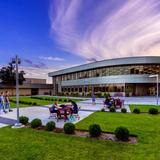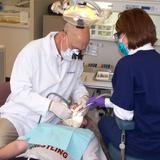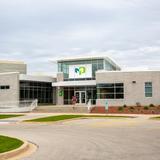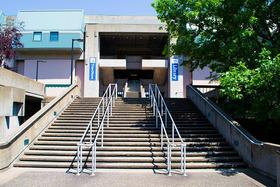- Northeast Wisconsin Technical College is a two-year technical college, serving northeast Wisconsin by providing education, training, and life-long learning opportunities for individuals and businesses leading to the development of a skilled workforce. Our customers stimulate the economic vitality of our district as a result of the application of skills and knowledge acquired through the completion of certificates, degrees, diplomas, and courses.
School Highlights
Northeast Wisconsin Technical College serves 15,271 students (19% of students are full-time).
The college's student-teacher ratio of 18:1 is higher than the state community college average of 16:1.
Minority enrollment is 22% of the student body (majority Hispanic), which is less than the state average of 35%.
Quick Facts (2025-26)
- Enrollment: 15,271 students
- In-state tuition: $4,198
- Out-state tuition: $6,036
- Student-teacher ratio: 18:1
- Minority enrollment: 22%
- Source: Integrated Postsecondary Education Data System (IPEDS)
Top Rankings
Northeast Wisconsin Technical College ranks among the top 20% of public schools in Wisconsin for:
Category
Attribute
Community Size
School Overview
The teacher population of 832 teachers has stayed relatively flat over five years.
Northeast Wisconsin Technical College
(WI) Community College Avg.
Carnegie Classification
Associate's Colleges: High Career & Technical-Mixed Traditional/Nontraditional
Associate's Colleges: High Career & Technical-Mixed Traditional/Nontraditional
Institution Level
Less than 2 yrs
At least 2 but less than 4 years
Institution Control
Public
Public
Year Founded
1912
Total Faculty
832 staff
419 staff
School Calendar
Student Body
The student population of Northeast Wisconsin Technical College has grown by 36% over five years.
The student-teacher ratio of 18:1 has increased from 13:1 over five years.
The Northeast Wisconsin Technical College diversity score of 0.38 is less than the state average of 0.55. The school's diversity has stayed relatively flat over five years.
Total Enrollment
15,271 students
5,183 students
Student-Teacher Ratio
18:1
16:1
# Full-Time Students
2,960 students
798 students
# Part-Time Students
12,311 students
4,385 students
# Enrollment Undergraduate
152 students
373 students
# Full-Time Undergraduate Students
2,960 students
798 students
# Full-Time Graduate Students
n/a
27 students
# Part-Time Undergraduate Students
n/a
4,624 students
# Part-Time Graduate Students
n/a
15 students
Total Dormitory Capacity
n/a
148 students
% American Indian/Alaskan
3%
1%
% Asian
3%
4%
% Hispanic
10%
10%
% Black
3%
9%
% White
78%
65%
% Hawaiian
n/a
n/a
% Two or more races
2%
3%
% Unknown races
n/a
8%
Diversity Score
0.38
0.55
College Completion Rate (Students who graduate in less than 4 years)
50%
48%
College Completion Rate (Students who graduate in 4 years or more than 4 years)
n/a
22%
Average Graduate Earnings (10 Years)
$35,300
$34,300
Tuition and Acceptance Rate
The public in-state tuition of $4,198 is more than the state average of $4,194. The in-state tuition has declined by 9% over four years.
The public out-state tuition of $6,036 is less than the state average of $6,373. The out-state tuition has declined by 10% over four years.
In-State Tuition Fees
$4,198
$4,194
Out-State Tuition Fees
$6,036
$6,373
Tuition Notes
$168 per credit
% Students Receiving Some Financial Aid
54%
76%
Median Debt for Graduates
$11,250
$11,250
Median Debt for Dropouts
$6,368
$5,500
Acceptance Rate
n/a
88%
ACT Composite
n/a
21
ACT English
n/a
19
ACT Math
n/a
20
Source: 2024 (or latest year available) Integrated Postsecondary Education Data System (IPEDS) , School Administrators
School Notes
- School Mascot: Eagle
- Northeast Wisconsin Technical College is a publicly supported, high technology college working closely with businesses and residents of Northeast Wisconsin to provide the education that residents and employers need. Schools sprang up in Green Bay and Marinette in 1913, followed in 1941 by a school in Sturgeon Bay. Their scope expanded to include adults of all ages who were interested in technical careers, whether or not they were in the workforce. In 1968, the three schools joined to become a single district in what is now the Wisconsin Technical College System. The combined service areas of the Green Bay, Marinette, and Sturgeon Bay campuses include part or all of nine counties. Today, NWTC offers over 70 Associate Degree and Technical Diploma programs, nearly 40 certificates, contracted business services, personal enrichment and continuing education courses. This wide range of programs serves a wide variety of needs; in an average year, NWTC serves one in eight District residents, or nearly 40,000 people. The Green Bay campus is the largest of the three campuses. The growing complex includes the District offices, a police and fire-fighter training center, and specialized education buildings for hands-on education in business and information technology, health occupations, construction trades, manufacturing technology, and protective services. NWTC is a member of the Wisconsin Technical College System. We are accredited through the North Central Association of Colleges and Schools Commission on Institutions of Higher Education.
Frequently Asked Questions
How much does Northeast Wisconsin Technical College cost?
Northeast Wisconsin Technical College's tuition is approximately $4,198 for In-State students and $6,036 for Out-State students.
What is Northeast Wisconsin Technical College's ranking?
Northeast Wisconsin Technical College ranks among the top 20% of community college in Wisconsin for: Largest student body.
Recent Articles

The Rise of Technical and Vocational Training in 2025
Explore the 2025 surge in technical and vocational training—enrollment, policy, costs, and why this path is gaining ground for students and parents.

Stackable Credentials: How Community Colleges Advance Careers
Discover how community colleges use stackable credentials to build career pathways, boost earnings, and enable lifelong learning in 2025.

High-Paying Jobs You Can Get with a Community College Degree
Discover top high-paying careers you can launch in 2025 with a community college (associate) degree and high-growth credentials in tech, healthcare and trades.












